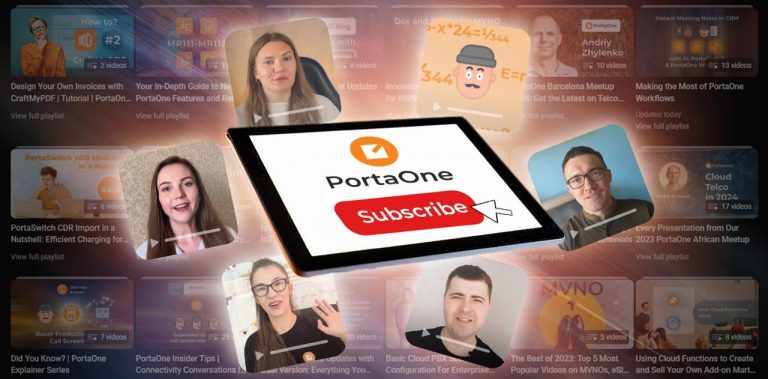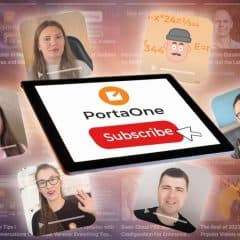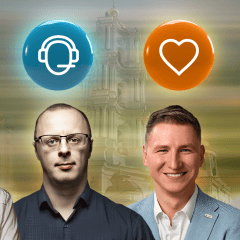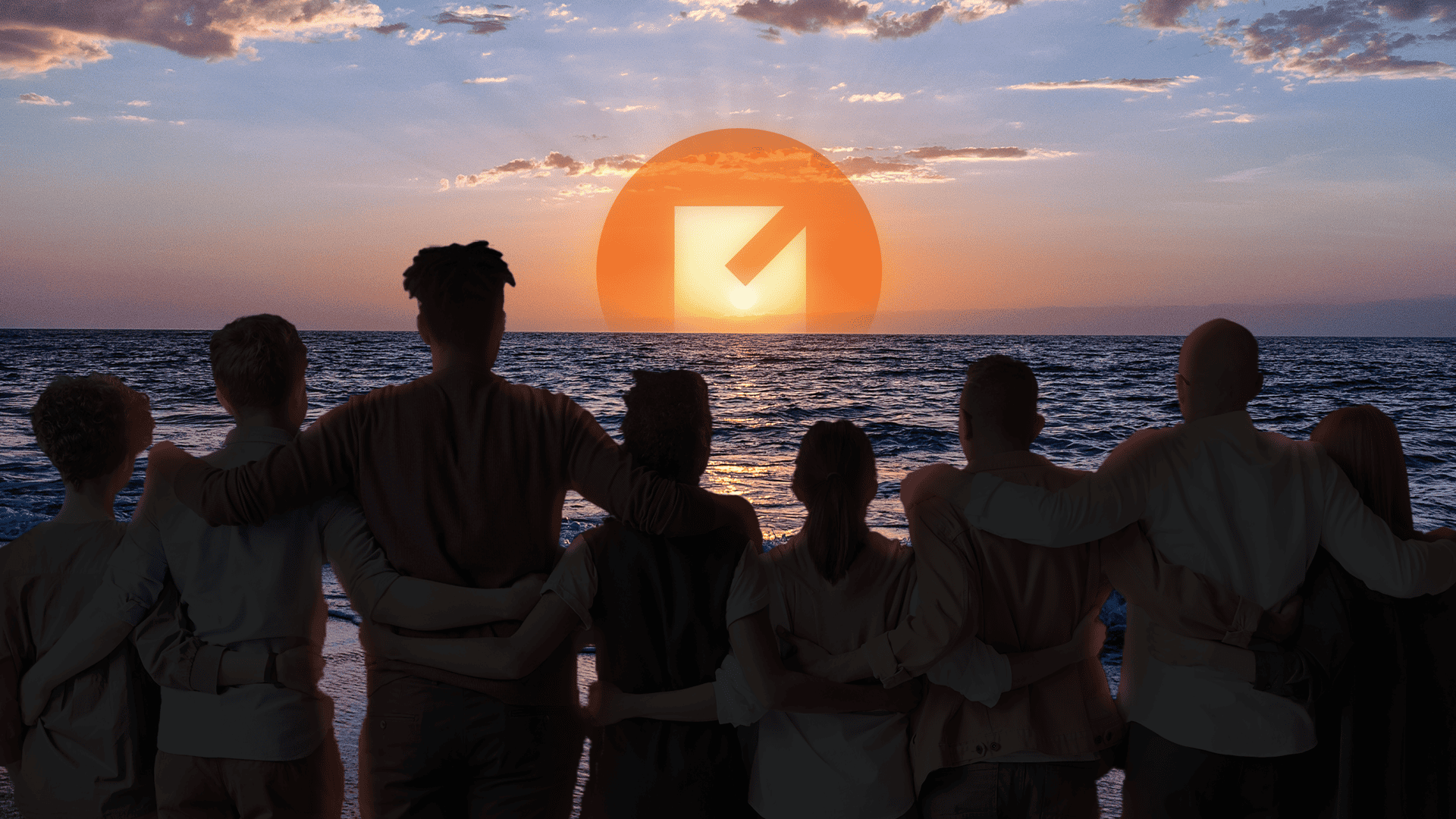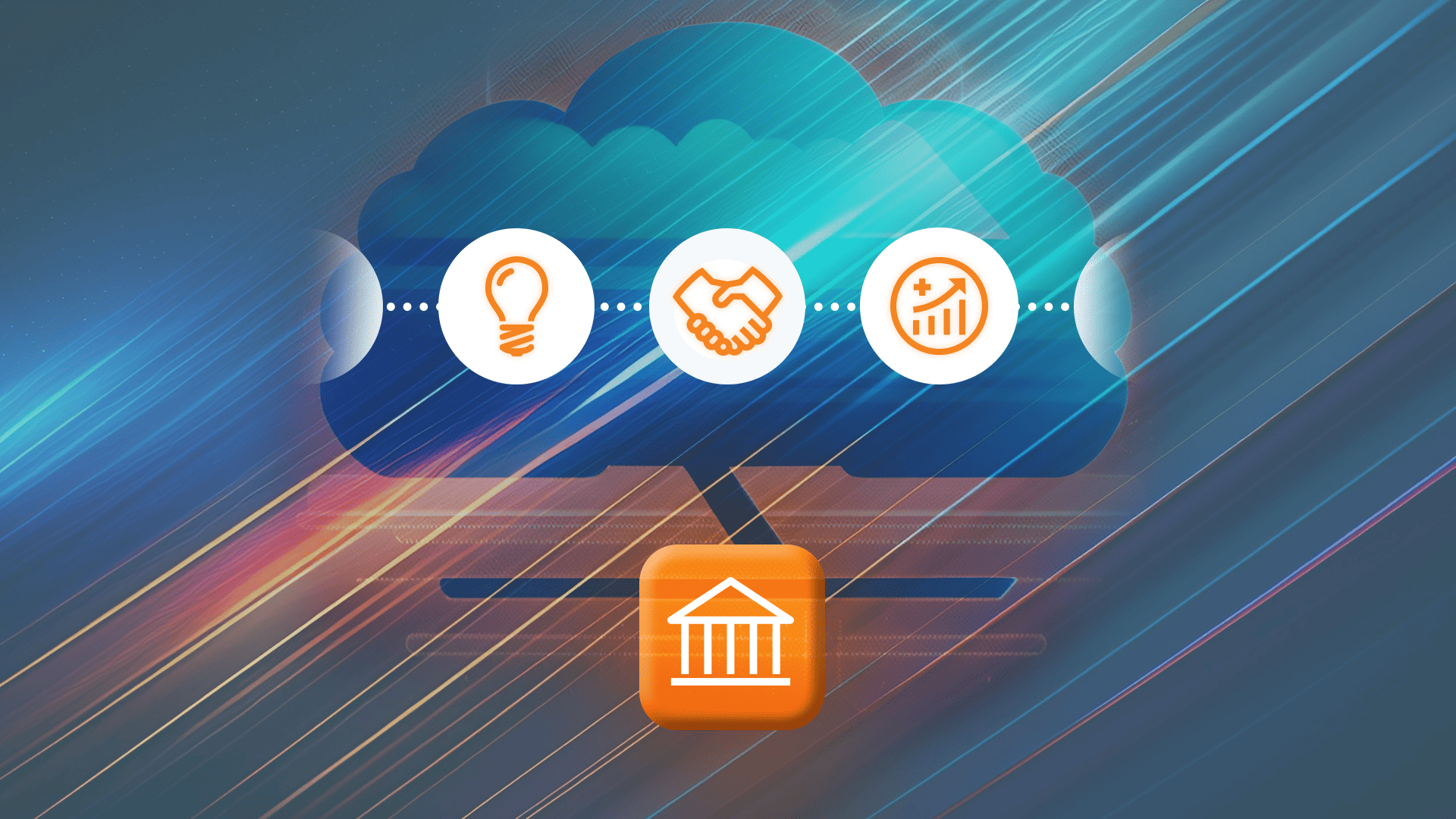PortaOne’s YouTube channel deserves a featured blog story for many reasons. With 2.49 billion monthly active users as of 2024, YouTube is second only to Facebook’s social network (3.06B MAU). It is also the world’s largest video-sharing service by both MAU and by the terabytes of data stored and served. PortaOne’s love story with YouTube was bumpy and somewhat unique.
Like Cinderella tales, it all started with underappreciation. In the early 2010s, PortaOne used YouTube mainly as a free video hosting, like many other small businesses. However, hello 2020s, and we were brainstorming ways to create better PortaOne YouTube content. The team of PortaOners is actively engaged in our YouTube evolution tale and includes some truly unique people. Their stories are worth telling.
PortaOne YouTube: from a “Free Video Hosting” to a Long-term Strategy
“The PortaOne YouTube has existed since 2010. It was a “user account,” not even a “channel” within YouTube’s customer hierarchy,” recalls Andriy Zhylenko, our CEO. However, until the 2020s, we mainly used it as a “free video hosting server,” Andriy explains. By 2019, small and medium businesses in consumer tech had widely adopted YouTube. It was evident that YouTube was soon to arrive in the telecom SaaS. Therefore, PortaOne started envisioning our content marketing strategy for the next decade. We extensively researched the content marketing channels of our key competitors (Cisco, Twilio, Broadsoft, and RingCentral, among others).
Twilio stood out. Their channel featured “built with” developer success cases, “around the world” community videography, pitches, and UI walkthroughs from the startups that adopted Twilio for their business. We were inspired. However, with $1.76 billion in revenue (as of the time of our 2020 research) and operating at a net loss (that is, spending even more than that — still the case as of Q1 2024), Twilio could afford the production costs of that marketing mix. So we asked ourselves: how might we get similar quality content with a marketing budget that our business size allowed at that time?
Gen Z, Gen Alpha, and the Marketing Comms
“And the communized loudspeakers! Never has such a curse descended upon America…” Jack Woodford wrote in 1929 in an essay titled “Radio: a Blessing or a Curse?” Each time some new technology gathers momentum, a “blessing or curse” debate appears around it. While YouTube got some (deserved) criticism, even critics admit that it changed the World, transforming video sharing and online streaming (collaterally killing the good old TV). Below, we give some considerations that shaped our vision for the growth of the PortaOne YouTube channel throughout the early 2020s.
Why Don’t We Buy Super Bowl Ads for the PortaOne YouTube
“Back in the 2000s, when we started, conventional TV was out of reach for B2B technology startups, which PortaOne was back then,” explains Roman Khalenkov, Chief Commercial Officer of PortaOne. Of course, there were some exotic Super Bowl ads for tech companies in the dotcom era, during the cryptocurrency craze of the late 2010-s, and even now.
However, it’s useless to target the potential market of a dozen thousand prospects (mainly engineers turned business owners) with a superbowl ad. Therefore, how might we create an online community around our business and incentivize it to watch our content regularly?
Creating Our Own (Branded) Telecom Show Online
Before YouTube, imagining a late-night show dedicated to MVNO, data top-up automation, call supervision, or call center setup was tricky. Of all the TV networks, it is on a one-time basis only. YouTube gave momentum and growth to industry media, such as TelecomTV, GSMA Channel, and our favorite partner—Tech Africa News. Now, niche specialists (CPaaS included) could launch without the costly studios and broadcasting fees.
Thus, YouTube collectives and solo entrepreneurs covered SaaS (for example, MicroConf, YCombinator, Dan Martell’s SaaS Academy, or TK Kader). They offered a new “decentralized” and self-produced generation of exciting and engaging business content. PortaOne collaborated with this new telecom media elite on several projects, and then… we decided to experiment with turning our team members into YouTube influencers.
Employees Become Anchors and Office Corridors (as well as Kitchens or Bomb Shelters) — the Corporate “Production Studios”
“One of my biggest initial discomforts was the fear of the camera. We all got used to videoconferencing, even before COVID and the lockdown. However, when you are teleconferencing with a limited group of people — that’s one thing. And when you are intentionally recording something that is supposed to be fun and entertaining for the multibillion YouTube audience — that’s quite another story,” explains Dmytro Lavraniuk, PortaOne’s senior business analyst and the co-host of PortaOne’s “Insider Tips” and “Innovative Revenue Strategies for MVNOs” YouTube series.
The full-scale russian invasion shifted the scope of Dmytro’s fears. It also changed the perception of YouTube among many PortaOne employees. “We monitored the SaaS video marketing boom,” recalls Andriy Zhylenko. After some preparations and armed with the best practices from our research, PortaOne ventured into the new space.
Getting People to Speak for PortaOne YouTube
“Getting people to “speak on camera” was quite a task. Everybody who has ever been a public speaker can relate to that, and the camera could be no less scary than the crowded audience, even for experienced presenters. Also, it’s never easy to be the first, leading by example.”
“Adding to that, it takes a lot of time and effort to make a successful shot even for a couple of minutes video, so it’s not easy to squeeze it in the busy working schedule,” recalls Tatiana Massalskaya, Head of Marketing at PortaOne. However, after some time and effort, a group of employees emerged within the PortaOne team. We call them “agents of the changes.”
The Agents of the Changes Arrive (on PortaOne YouTube)
People become agents of change for a reason. They somehow get different cultural perspectives, life strategies, and creative confidence to lead a successful change. In this section, we highlight personal stories about the key movers and shakers of the PortaOne YouTube channel.
@Sat and His (Not So) Secret PortaOne YouTube Muse
Oleg Shevtsov is a PortaOne veteran. Our regular readers might remember him from the “True Gems” story. He has led the PortaCare team since 2009 and became the head of our Project Management Office in 2013. What is interesting about his story is that Oleg’s wife, Svyatoslava Blashchuk, is a producer and anchor of the Jedi Kryivka—a YouTube Star Wars fan channel covering all aspects of George Lucas’s media franchise for the Ukrainian audience.
Svyatoslava’s channel boasts the largest audience among Ukrainian Star Wars YouTubers. She is also the author and anchor of Tereveni in Cantina, a syndicated Star Wars-themed Ukrainian language podcast distributed via Spotify for Podcasters. It’s probably worth explaining the naming nuances of both shows.
What Do “Tereveni” and “Kryivka” Have to Do with Star Wars, YouTube, and the International Media Franchises and How is This Relevant to Talent Acquisition by PortaOne
“Tereveni” is “small talk” in Ukrainian, while “kryivka,” well — that’s where things start getting political. “Kryivka” is a name for dug-outs used by the Ukrainian insurgents during WW2. There’s even a trendy (and well-ranked) dining place in Lviv by the same name, and (unfortunately) “there’s no need to pretend now,” as Patricia Cohen from the New York Times had aptly put it in her review.
The problem with “tereveni” and “kryivka” is that Ukrainian YouTube customers don’t get to see them often. Google is using discriminatory ranking policies toward Ukrainian-language content in favor of Russian-language content, a practice stemming from someone’s belief (in Mountain View or wherever) that this language is more popular and widely used in Ukraine than Ukrainian. Not convinced? Oleg Shevtsov conducted Obi-Wan Kenobi and King Kong tests for you to prove his point.
So, instead of living the lavish lifestyle, supported by Svyatoslava’s generous royalties from the high-quality local Star Wars franchise content, Oleg had to continue his modest hard work as the Ukrainian tech PM 😅 at PortaOne. Nevertheless, Oleg learned to adapt the family’s YouTube vlogging experience into YouTube marketing videos for PortaOne, making him and his co-host Dmytro Lavraniuk our favorite late-night PortaOne show hosts. Now it’s time to tell more about Dmytro.
@Mitchell: Our Perfect English Voice from a Bomb Shelter in Sumy
Like many of our employees, Dmytro Lavraniuk arrived at PortaOne from academia. “I graduated from the Foreign Languages Department of Sumy University and then taught English Grammar and Phonetics 101 for a few years in the same Department before I decided to become a student of the College of Tourism and Hotel Management in Cyprus. But life is unpredictable, so I returned home after graduation to find myself in engineering. For the next five years, I worked as a technical translator at the Research and Development Institute of Nuclear and Power Pump Engineering, designing worldwide equipment for nuclear power plants. This year, a russian bomb destroyed the institute and all the technical documentation I had translated to English for many international projects from India, Germany, and China.”
How Did @Mitchell Decide to Become a YouTube Creator at PortaOne
“It all started as a task for management during the COVID times. We sought ways to promote PortaOne products when on-site visits, training, exhibitions, and trade shows were on hold. After some time (and experimenting), it became fun. I realized the power of YouTube, and it was amazing to see how many prospects and leads got to know what we are up to by watching the PortaOne YouTube channel. Now, when I jump on a call with somebody who says, “I know what you are talking about — I saw your YouTube video,” it feels as if we have just skipped a “zero” phase during which I would normally have to spend half an hour explaining who we are, what we do and why.”
CloudCity at MWC: Dmytro’s PortaOne YouTube Debut
“My first video was quite challenging — the PortaOne team presented at MWC 2021 in Barcelona. There were crowds of people around, and it was lockdown time. Therefore, we had to wear masks. We sat down with Oleg at the Telco DR Cloud City booth, picked a moment when people had lunch, and recorded a video “from the frontlines.” It wasn’t quiet in Cloud City, and we had to speak with thick masks. But the prior experience of being a PortaOne demo engineer was my secret advantage: you get used to presenting effectively under any conditions.”
Working in a Duo: How Do Oleg and Dmytro Share the PortaOne YouTube Airtime (and the Burdens of the Show Production)
“Oleg is my boss in the off-show life. However, he is not “the bossy boss,” preferring an intellectual leadership style. That’s why sharing the airtime (or show production responsibilities) never was a problem. We rehearsed before our first videos in the early times of our YouTube career. Usually, that was 20 minutes to discuss the topic, a couple of funny visuals, and then one cut to record it.
It sounded like a real-life friendly chat between the two telecom SaaS enthusiasts. Before the show, we discussed the key punchlines and how to make our videos “brighter,” easier to understand, and more appealing.”
With time, Oleg (@Sat) and Dmytro (@Mitchell) slightly changed the production routines and timeline. Oleg was usually busy running the whole PM unit — the PortaOne PM team does much more for our customers than just recording funny videos. Therefore, Dmytro started writing scripts for both Oleg and himself. The friends would then record their sequences and take turns syncing and editing the video fragments for the duo. “Now it was less fun, but we polished the sound and pronunciation to a pro-level, each of us making as many tries as was needed until we felt it passed our personal quality standard,” recalls @Mitchell. The visuals also got professionalized after our young design star, Damian, joined the team.
Vlogging for PortaOne YouTube Under the Enemy Bombs
“Once I spent over 2 hours producing a 7-minute fixed LTE video,” laments Dmytro. Knowing the industry, we should admit that’s quite an adequate editing-to-production ratio. However, Dmytro wasn’t happy for a reason. “I had to stop the recording several times because of the air raid sirens [writer’s note: those sirens are loud, and they “spoil” the soundtrack]. It wasn’t easy to focus on the matter, knowing that a russian missile could cover a distance of 30 kilometers from the international border to my city in minutes if not seconds.”
“When the air raid was over, and I put the microphone back, my neighbors came home and spoke so loud that I had to wait for them to leave again. In the final seconds, when I was going to wrap up the video, a dog started barking in the street. So I had to do another cut because of the poor animal. We all lose our nerves with enemy rockets flying around.”
@Damian — the Creative Prodigy of PortaOne YouTube
If we ever have to write a film scenario based on the stories told in this blog, the life story of our interactive designer, Damian Chudynovych, would be at the top of the list. Damian grew up in Kherson, in a Christian priest dynasty. His grandfather was among the founders of the Ukrainian Orthodox Christian Church, which had been fighting for autocephaly for two decades. They finally got it in 2018 from the Ecumenical Patriarch of Constantinople. Damian’s father, Serhiy, followed the paternal path by joining the Ukrainian Orthodox seminary and becoming a priest.
“It looked like family tradition predefined my path,” recalls Damian on a video call during the midsummer heat. However, Damian felt he was different and faithful but not religious. That’s why, when the time to get higher education arrived, Damian enrolled in the Faculty of History at Kherson State University.
“It was an intellectual give-and-take between me and my father. History and psychology are the closest you can get to faith, yet it is liberal, not doctrinal education.” Despite being open about his dreams of his son’s career choice, Serhiy took a vivid interest in Damian’s studies, sharing his perspective on the history of the World and Ukraine. Serhiy’s particular interest was in Antiquity when areas around Kherson and southern Ukraine were Greek colonies.
It’s 2022. Kherson is Occupied, and Damian’s Father is Captured and Tortured
Damian was a bachelors degree student at Kherson U when his intellectual duels with his father were interrupted by the full-scale russian invasion of Ukraine. “During the first hours of the invasion, father transported mother, me, and my brothers and sisters [Damian has three siblings] to a safe place in Central Ukraine.” Serhiy returned to his parish in Kherson to lead them spiritually through the turbulent times.
There was a lack of medicines and other supplies in the occupied Kherson. So, Serhiy risked his life driving several times a week back and forth from the occupied area through the combat lines to free Ukraine (mainly the city of Mykolaiv). This traveling routine ultimately got him arrested by the russian FSB at the end of March 2022. Seriy was brutally interrogated, beaten, and tortured, all just for helping his parish. However, after some time in russian captivity, Serhiy was released to the great relief of his family. Serhiy’s fellow clerics in Zaporizhia Oblast weren’t that lucky.
“Being repressed and tortured is not something new to my family,” Damian explains with bitter irony. The Soviet KGB regularly interrogated his grandfather in the 1970s and 1980s. Being a pro-Ukrainian Greek Orthodox Priest was indeed a deadly combination for a human being under the Soviet regime. Nevertheless, generations of Chudnovyches continued serving their parishes, no matter the circumstances.
Becoming a Professional Motion Designer During the War
Forced to become an adult at a very young age, Damian understood that despite his father’s traumatic experience as a civilian POW, his parents still had to care for his younger brother and sister. That’s why he decided to move to Kyiv and earn money alone. However, you won’t make a ton of money teaching the history of Ukraine to other kids of almost your age. That’s when Damian started considering his long-time hobby as a money-making profession.
“My interest in video editing and motion design began early in university. After discovering YouTube sci-pop channels such as Kurzgesagt, Alan Becker, and the Armchair Historian, I realized the power of YouTube (mixed with some simple animation and motion design skills) for explaining complex concepts, such as historical events. I tried experimenting on my own and tried various platforms. Luckily, my arrival to the profession coincided with the advent of generative AI,” explains Damian.
Getting Hired by PortaOne — the Lucky Match for PortaOne YouTube
“I drafted a resume and started sending it out via Djinni [an online job search service preferred by the Ukrainian tech crowd],” Damian explains. The problem was that I didn’t have much to include in the “previous professional experience” section. That was June 2022. Damian was a fourth-year University student and an internally displaced Ukrainian.
Skip just two years, and Damian has one of the most impressive portfolios in his industry niche. He helped us finish the new version of the PortaOne website, revamped and streamlined the creation of cover images for this blog, and, ultimately, in 2023, started producing interactive videos for the PortaOne YouTube channel.
“PortaOne’s HR strategy is to accept young, talented people. Often, we are among their first [if not “the first,” like in the case of Damian] employers. However, Damian surpassed even my optimistic expectations,” explains Andriy Zhylenko. The environment in which our young designer had grown up and the history discussions with his father shaped Damian’s outstanding professional qualities.
Damian Explains His Creative Process
“Please mention that I’m quite a shy person,” Damian said at the end of our conversation. “Much so that I voiced the “making of” video with the help of an app since I couldn’t record any version of my voice for a week.” Damian’s comment highlights an interesting situation: there was a lot of discussion on how “the machines will steal employment from humans.” While yes we could have hired a voice actor for the job, we would likely have decided not to make this video.
Therefore, instead of “stealing work” from humans, AI/ML created the blue ocean of content opportunities in this case. Without ElevenLabs, Brian Damian would not have made his “making of video” by shying away from his Ukrainian accent when speaking English. The AI tool empowered him to create new and valuable content and helped us better explain the making of PortaOne YouTube with more neat nuances.
How @Stacy (and the Documentation Team) Taught Us Creating Release Notes Everyone Watches
“Let’s face it: the sales documentation for telecom is boring, while the adrenaline and the champagne of a successfully closed deal is fun,” ironizes Roman Khalenkov. PortaOne has been (successfully) shortening the notorious MR Gap for quite a time. Ironically, the MR Gap results from:
- Our older releases (think old, like 2010) are able “to work just fine” for decades, without any interference on behalf of the customer and
- Our customers’ owners and top managers ignoring 👹 the release notes, which contain many features that improve their lives (and profit margins).
Early in 2024, PortaOne product documentation and marketing teams decided to collaborate and create a content product that would change how our customers and prospects treat product release information.
Welcome, @Stacy, the Product Release Diva of the PortaOne YouTube
“After joint ideation, we decided: what if somebody from the tech documentation department, a live human being, explained the new release to our customer community in a human language? Anastasiia Holota (a.k.a. @Stacy), our technical writer, volunteered. The outcome amazed us,” explains Tatiana Massalskaya. We got over 210 organic views during the first week — an unusual outcome for a SaaS marketing video without any paid promotion (people who run corporate YouTube channels (not for Google or Apple) will understand).
“When was the first time I used a computer? That was my older brother’s game, GTA III, and I was in 9th grade in the mid-2000s. You had to press the “Power” button on a desktop module. My first experience with the Internet? I used a Nokia slider phone to access some early chats and social networks while my parents were not watching. That was even before the GTA. You had to install Opera Mini on your Nokia and wait for half an hour before the webpage loads.”
@Stacy at PortaOne: A Neverending WFH that was Never Intended
PortaOne hired Anastasiia as a call center operator in Chernihiv in 2020, just two weeks before the COVID lockdown had started. “So I managed to meet my boss and colleagues “for real.” Then we took our office laptops home. I worked from there for over a year. Therefore, I was participating in the “normal” office life and experiencing all the newcomer’s fun mainly via Slack. In 2021 we started getting “we might be soon back to our Chernihiv office” notifications every two or three months. Then it was 2022, and we were still getting those notifications. Then russians launched their full-scale invasion. I ended up working for PortaOne from home for over four years already.”
Looking at the Future Growth of PortaOne YouTube
“Two years ago, colleagues from sales were skeptical about PortaOne YouTube. Now prospects come to them saying, “We watched your YouTube channel.” Therefore, it became a source of leads and an instrument to improve brand recognition. This is an outcome of the tremendous efforts by various content teams at PortaOne,” Oleg Shevtsov is proud. Indeed, our customer community is already paying back the efforts of the marketing, product documentation, and PM and sales support teams. We asked the people we interviewed about this story and their vision of the future growth of PortaOne YouTube. Here are some bullet points.
More Direct Customer Speech
In practice, customer video testimonials (like these) explaining our new features work way better than general-purpose marketing videos. Customer-centered marketing is at the core of PortaOne customer communication.
Simplified UI/UX Animations
We plan on using more simplified UI/UX animations instead of screencasts. PortaOne relied on screencasts a lot in the past. We then observed that the viewer looks primarily for the main idea of the feature without digging into details. Thus, if we accentuate the critical UI elements and remove the rest, it will work akin to professional makeup: only the necessary elements get highlighted.
Podcasts!
PortaOne YouTube channel has scheduled (monthly and weekly) shows that will eventually become podcasts. “We all know the power of the habit,” explains Tatiana Massalskaya. That’s why the PortaOne YouTube team started posting regular updates on specific weekdays or days of the month to form a viewing habit among our audience. “We also would like to shift customer education focus to a several-month podcast series, especially in the advanced certification. This way, customers can educate themselves about the advanced features of the PortaOne products without interrupting their regular working or leisure routine,” adds Tatiana.
Virtual Characters and Mascots of the PortaOne YouTube
“Since the times of Clippy and Mac v. PC dudes, virtual characters have helped businesses establish an emotional connection with their customers, create better rapport, and explain complex tech and business concepts,” says Damian Chudynovych. We plan those for PortaOne YouTube. However, this level of video editing requires a substantial time budget for an in-house motion designer or financing for external professionals. “We know mascots are important. However, please be patient; it takes time,” Damian adds.
Direct UI Commands from the Video (or its Description)
“Most of our UI is web-based,” explains Mike Kidik, PortaOne’s Chief Product Officer. “This means not only we can demo what should be done and explain why, but we can sometimes give direct interface commands to customers in the video captions or description to save them time.”
Integration with Other Content Types
Videos from the PortaOne YouTube channel will continue to be embedded in our knowledge base, this blog, the PortaOne corporate website, sales presentations, online customer conferences, white papers, etc. We already use built-in YouTube features to cross-reference our videos and playlists.
Combining Physical and Digital Spaces via PortaOne YouTube
“Since our first PortaOne Virtual Customer Conference in 2021 (and the subsequent PortaOne vCC22) we gradually learned best practices of combining the digital and physical customer communication,” explains Tatiana Massalskaya. “Originally that was a necessity (first — COVID, then — war). With time PortaOne learned to turn its vulnerability into a strength. We always welcome those customers, who can afford traveling to various regional customer events, such as our 2023 African Meetup or European Meetup 2024. However, we also work hard to make it possible for our customers to “attend” such events via digital, and this means designing a completely interactive digital experience, not just a YouTube webcast.”
Building the New Content Partnerships
Once the PortaOne YouTube channel started enjoying its regular viewer base, we began receiving requests for cooperation from various other SaaS vendors, such as Pharos, Nordic eSIM, WTL, Xero, Quickbooks, CraftMyPDF, and others. Content collabs rule the modern marketing world. That’s why you will definitely see more of those from PortaOne. We want to do those with our signature style (and a bit of humor).

